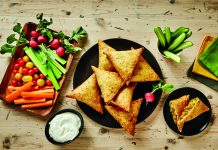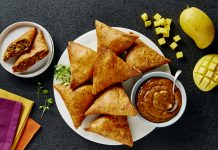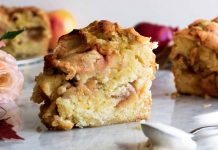This salad embodies me on a plate. It takes childhood experiences and intersects them with South Asian flavours and ingredients. Each bite is a redefinition of the journey towards home.
Born and raised in Kamloops, the Adams River salmon run was a huge part of the field trip experience of my elementary school years. I admit at the time, I was dismissive of nature. My naive approach to life didn’t really understand the connection to nature. Something so far removed from now, when I am constantly humbled and fascinated by it. The cyclical nature of the salmon run hits a nerve; the no end and no beginning is poetic.
Before I get super philosophical, let me explain why the journey of salmon is important. Adams River salmon travel from their home (spawning grounds) to the South Thompson River, into the Fraser River, and then into the Pacific Ocean. The Strait of Georgia is their passageway into the big ocean, where they spend three years. In that time, they follow the Arctic currents to Alaska and the Aleutian islands. When they are ready to return home, they travel for nearly twenty days, upstream, navigating challenging obstacles along the way. In total, they swim, round trip over 4,000 kilometres and only 4 out of every 1,000 actually survive.
The negotiation and actual journey they take is not dissimilar from many of our own journeys. As for the salmon, their goal in life is to find the very patch of gravel where they were born.
Returning home is an insanely inconvenient thing to do. If the salmon would just lay their eggs a stone’s throw upriver from the ocean, everything would be so much easier. But who likes easy, right?
For me the key to a good salad is a light dressing, simple ingredients, and a good mix of textures and colours. For this salad, I have followed a formula: mixed salad greens, tangy guava slices, crunchy goodness in the form of pappadums, and luscious smoked salmon. This is all dressed with a horseradish raita which acts as an edible glue, and a light tamarind dressing that packs an acidic bold punch.
 Salmon and Guava Stacked Salad with Horseradish Raita and Tamarind Dressing
Salmon and Guava Stacked Salad with Horseradish Raita and Tamarind Dressing
4 cups of spring salad mixed, washed and dried
3 guavas, sliced thinly
1 package of smoked salmon
12 pappadums
Horseradish Raita (recipe below)
Tamarind Dressing (recipe below)
Jalapeno (sliced and option).
Directions
Toss spring salad mix with a few tablespoons of dressing in a large bowl (less is more). On a large plate, spoon tablespoons of horseradish raita, spreading it out. Add a bit of spring salad mix and then pappadum. More spring mix and then guava slices and smoked salmon. Drizzle a teaspoon of tamarind dressing and then a spoon of horseradish. Top with another pappadum. Repeat the ingredients and then top with pappadum, spring salad mix, guava and smoked salmon. Add a drizzle of dressing and then jalapeño slices. Serve immediately.
Tamarind Dressing
2 1/2 tablespoons warm water
2 tablespoons fresh lemon juice
1 tablespoon honey
1 1/4 teaspoons tamarind concentrate
2 teaspoons Sriracha
3/4 teaspoon salt
1/2 teaspoon ground black pepper
1/4 cup vegetable oil
Directions
Whisk together water, lemon juice, Sriracha, honey, tamarind concentrate, and salt and black pepper in a small bowl. Add oil in a slow stream, whisking until combined.
Horseradish Raita
1/2 cup sour cream or greek yogurt (I prefer full fat sour cream)
3 tablespoons buttermilk
2 tablespoons creamed horseradish
3 tablespoons tamarind dressing
Directions
Whisk together the sour cream and horseradish. Gently stir in the tamarind dressing, do not fully incorporate.
Pappadums
12 pappadums
vegetable oil for brushing
ground cumin
Directions
Lay a few sheets of paper towel in the microwave. Brush papadums, two at a time, with vegetable oil and sprinkle one side of each with cumin. Microwave for 30 seconds. Continue steps until all 12 pappadums are cooked.
Jessie Kaur Lehail is the author of Indian Influence, a blog that shares food stories, recipes, and photography. Reflecting a love for meshing global flavours and South Asian aesthetics, Jessie explores culture and identity through food. Find more food stories at indianinfluence.ca



















![salman-guava-salad[1]](https://www.aaarzumagazine.com/wp-content/uploads/2016/08/salman-guava-salad1-696x724.jpeg)







